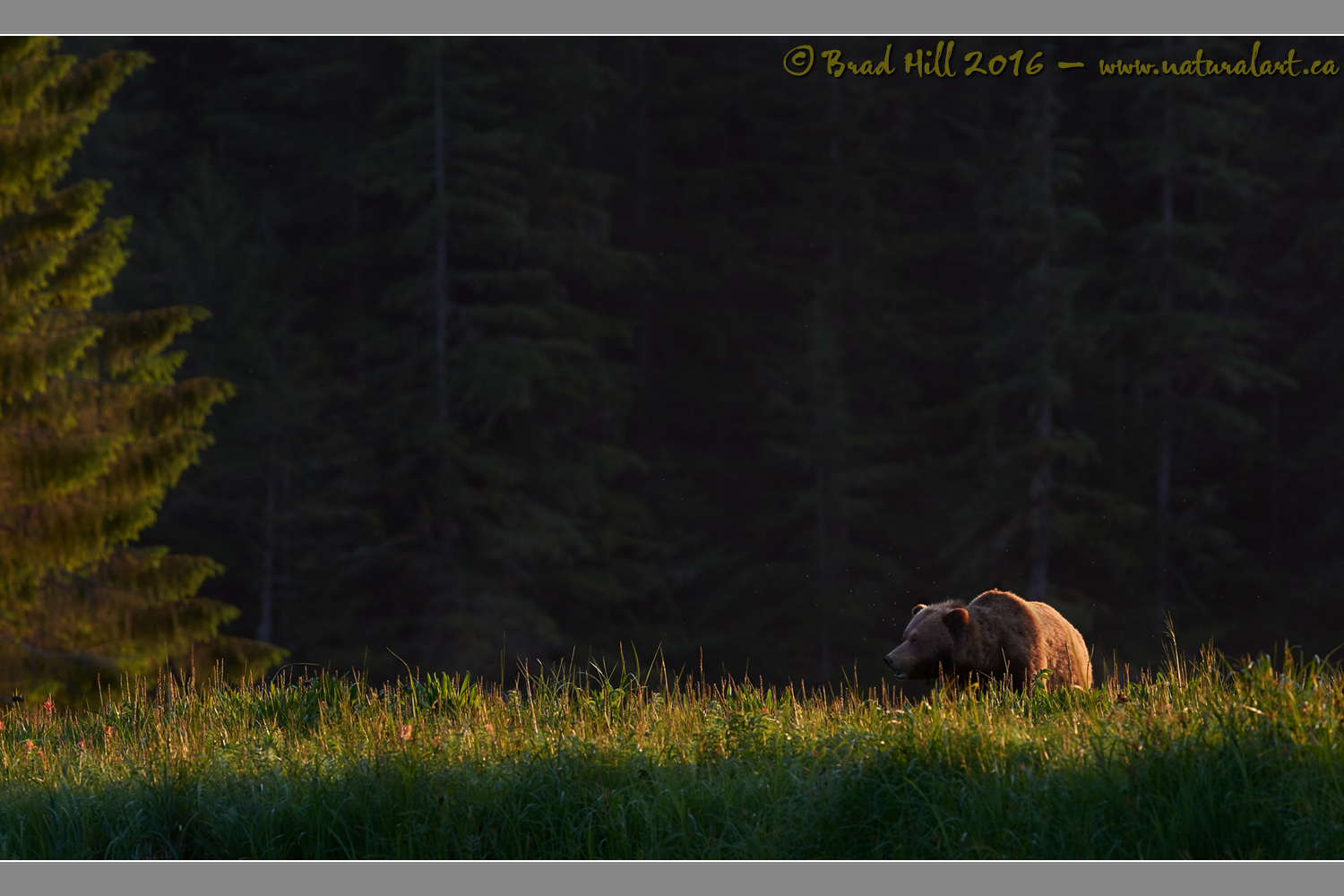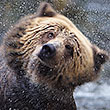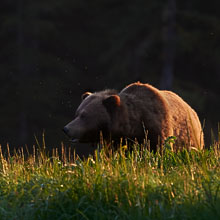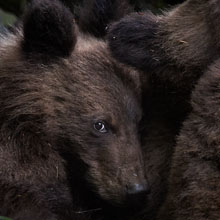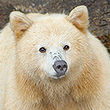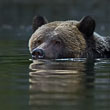Availability: Undetermined - Enquiries?
In the Field
Bedtime. Khutzeymateen Grizzly Sanctuary, northern BC coast, Canada, BC, Canada. May 30, 2015.
I captured this image late one evening in May of 2015. The sun was just going down, and so was the bear! We watched the bear quietly bed down only moments later. Dreamy light just before dream time. What could be better for a keen wildlife photographer? This opportunity was a good reminder that at the end of the day, it's ALWAYS about seeing and capturing the light...
I tend to like scenes and images that are on the very "edge" of what our cameras can capture and render. Commonly these scenes are outside of what the camera can capture "on its own" - meaning that the contrast or dynamic range is such that realistically rendering the scene requires a lot of post-processing work. This image - while really very simple and consisting of only 4 elements (the horizontal band of light, the softly illuminated tree, the bear, and the subtle background) - is a good case in point. While making the exposure in the field wasn't too tough (I only needed to under-expose the image by 0.3 stops less than the light meter "suggested" to retain all the highlights), I had to blend 5 different derivatives of the raw file (raw "clones" or "variants") that differed in exposure to get this one right (and note that here I'm using "right" in the sense of "in the way I remember the scene"). So not only was this scene outside where you could push a single raw file during processing, it is WAY outside what the camera could do on its own (which, of course, makes it WAY outside the in-camera "JPEG Zone").
Over the years I've noticed that a lot of neophyte and/or developing wildlife photographers put their cameras down just when things are getting interesting, like during strong side-lighting (as in this scene), strong backlighting, or whenever contrast is high. I'll grant that these situations often force the photographer to "take control" of their cameras (for instance, making exposure compensation decisions, and sometimes pretty extreme compensation decisions) and also demand that they understand what they can (and can't) do during post-processing. But if you want to capture compelling shots, you just gotta take those leaps at some stage! ;-)
This one kinda demands to be seen bigger - so here's higher-resolution (2400-pixel) version of it:
• Bedtime: Download 2400 pixel image (JPEG: 1.1 MB)
ADDITIONAL NOTES:
1. This image - in all resolutions - is protected by copyright. I'm fine with personal uses of them (including use as desktop backgrounds or screensavers on your own computer), but unauthorized commercial use of the image is prohibited by law. Thanks in advance for respecting my copyright!
2. This image was captured during one of my two spring "Grizzlies of the Khutzeymateen" photo tours in May/June of 2011. Each year I offer trips into two different parts of the Great Bear Rainforest as well as one to photograph aquatic mammals and oceanscapes near the northern tip of Vancouver Island. And, in selected years, I also offer photo tours to locations to capture other highly sought-after subjects, such as various boreal owl species and wildlife of Canada's Arctic. Details about these trips can be found on the Photo Tours page of this website.
3. Like all wildlife images on this website, the subject(s) is/are fully wild and completely unconstrained. Besides the potential impact of my/our presence, nothing has been done to intentionally alter or affect the ongoing behavior of the subject and, of course, there has been no use of any form of bait or other form of wildlife attractants (including vocalizations).
Behind the Camera
Bedtime. Khutzeymateen Grizzly Sanctuary, northern BC coast, Canada, BC, Canada. May 30, 2015.
Digital Capture; Compressed RAW (NEF) 14-bit format; ISO 2800.
Nikon D4s paired with Nikkor 400mm f2.8E VR. Hand-held from floating Zodiac. VR on and in "Sport" mode.
1/400s @ f8; -0.3 stop compensation from "recommended" matrix-metered exposure setting.
At the Computer
Bedtime. Khutzeymateen Grizzly Sanctuary, northern BC coast, Canada, BC, Canada. May 30, 2015.
RAW Conversion to 16-bit TIFF using Phase One's Capture One Pro 9. Five raw variants (different versions of a single raw capture) processed, with the variants differing in exposure (1.5 stop total difference between the variants) and shadow retrieval settings.
Further digital corrections on resulting 16-bit TIFF files using Adobe's Photoshop CC 2015. Photoshop adjustments included compositing (blending) of the five output files from the raw converter, minor exposure tweaks, and final selective sharpening for web output. No colour saturation adjustments (increasing or decreasing saturation) made during any phase of the post-processing.
Conservation
Bedtime. Khutzeymateen Grizzly Sanctuary, northern BC coast, Canada, BC, Canada. May 30, 2015.
Ten percent of the revenue generated by this image will be donated to Raincoast*.
Species Status in Canada**: Special Concern (May 2002).
While Grizzly Bears (Ursus arctos) are not technically listed as "Endangered" in Canada, they have been extirpated from most of their historical range. Grizzly Bears are far more sensitive to intrusion/disturbance in their habitat than are Black Bears and are being increasingly forced into marginal habitat by human encroachment. The Great Bear Rainforest along the central and northern coast of British Columbia is one of the last strongholds of the Grizzly Bear in Canada, and even this population is coming under increasing pressure.
On December 18, 2017 the government of British Columbia banned grizzly hunting across the entire province. This major conservation victory came after decades of tireless work by many dedicated conservationists and ecologists and, most importantly, it reflects the opinion of the vast majority of British Columbians. And, it means that AT LEAST while the current government remains in power grizzlies are finally "safe" in British Columbia.
Now that we've at least temporarily won the battle to save grizzlies in BC, it's time to re-focus our efforts toward protecting ALL of BC's carnivores, including Gray Wolves, Black Bears, Cougars, Wolverines, and more! Simply put, there are no ecological, economic, or ethical arguments supporting the trophy hunting of carnivores.
In a great first step towards ending the hunting of carnivores throughout BC the Raincoast Conservation Foundation has developed a program designed to protect ALL carnivores within the Great Bear Rainforest. Details about this program can be found on this page on Raincoast's website. Check it out and, better yet, make a donation to help Raincoast purchase the remaining commercial hunting tenures in the Great Bear!
*The Raincoast Conservation Society (and Foundation) is an effective and efficient organization that has been fighting for protection of this unique habitat. If you are looking for a meaningful way to contribute to the conservation of this amazing ecosystem, Raincoast will provide maximal "bang" for your conservation dollars.
**as determined by COSEWIC: The Committee on the Status of Endangered Wildlife in Canada












